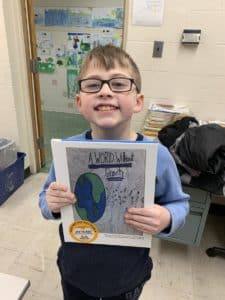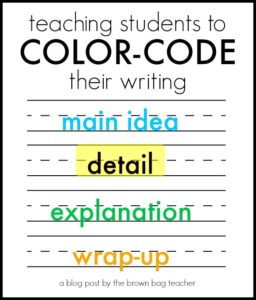 Learning 1st grade writing is a lot to handle and learning how to revise and edit writing is an important skill that eludes even adults, so it’s important to start elementary students early. Emphasize to your first-grade students that it’s about making the writing better, not what’s wrong with the piece.
Learning 1st grade writing is a lot to handle and learning how to revise and edit writing is an important skill that eludes even adults, so it’s important to start elementary students early. Emphasize to your first-grade students that it’s about making the writing better, not what’s wrong with the piece.
And while your students are certainly going to utilize invented spelling—who doesn’t love a good guessing game?—you want to find a balance between focusing on the technical aspects of writing and letting your 1st graders learn how to communicate their thoughts in a creative way.
Of course, as the year progresses, you know that the invented spelling will improve as will the writing, the latter of which will move leaps and bounds from barely formed sentences to full paragraphs.
Introducing Revising a Draft and Organizing Ideas into 1st Grade Writing
Below are some of our favorite devices to help first-grade students revise, edit, organize and improve their writing.
The Checklist
One of the best ways to help your students understand what they need to revise their writing is to provide a checklist of expectations. These expectations can range from breaking up blocks of writing into paragraphs to making sure their story makes sense from beginning to end.
Here’s a list of some expectations that might be good for your first-grade students:
- Make sure each paragraph starts a new thought
- My story makes sense from beginning to end
- My writing is organized and neat
- My sentences have punctuation and make sense when I read them aloud
A recommendation to help make the list more appealing to your first-grade students is to give them examples of organized writing. Use the books you have read in class or ones that they are familiar with to show them how thoughts can be presented in a methodical way.
A “why” for finishing the checklist: Students love a prize! So if your students find out that revising and improving their writing to create a final draft that meets all the items on your checklist, will be included—along with their own drawings—in a published classbook, it might be just the push they need to do their best and get excited about revising a draft.
Color-code the parts of the writing
As your students learn how to move from one-sentence answers to a full paragraph to make their point, consider highlighting the different parts of a paragraph with different colors to visually help them see what parts are included. Then, have your students do the same to double check that their paragraph has everything it needs.
The example (right) breaks up the writing into several sections, with each part color coded. This means that when your students look at their writing and can’t find a certain part to highlight, they need to revise their writing. These parts include:
- Main topic
- Detail
- Explanation
- Wrap up
Either you can show your students this example as a class, and then allow them to try to identify each part themselves. Or you can go through it with them individually, highlighting the parts and talking through with your students what’s missing and how to improve what is there - for times’ sake we suggest doing the former and giving them a guide to follow based on the chart above or your own example.
Peer editing—with direction

As we all know, editing your own work can only take you so far. It often takes a fresh set of eyes to point out something that needs to be revised, fixed or improved to make the piece of writing better.
Providing a safe and judgment-free zone for peer editing will set up your students for success. Make sure you emphasize that the critiques your students make need to focus on the improvement statements—I think you could _____ or Maybe you could add ____ instead of saying I don’t like ______.
So, have your students partner up and discuss the pieces. Because of the age, it’s probably easiest for your students to read their writing out loud to each other before discussing. . This exercise hits not only on the writing process, but also gives your students a chance to practice their social skills.
While it might be tough to receive criticism at such a young age, keep in mind, students will be providing it in a friendly manner that should be viewed as helpful suggestions to improve their writing. Plus, they will probably have fun listening to each other’s writing pieces and talking about what they wrote!
Help each other achieve: Give your students a reason to focus and help their classmates make their piece of writing the best it can be by telling them that their writing with an accompanying illustration, will be published into a classbook!
Model what you expect

Take a 4-5 sentence example paragraph, and use something like a smart board or other tool to show it to the whole class and visually highlight each item you want to discuss from how the piece was organized to punctuation.
Or, better yet, plan out a short piece that you can “write” for the students and self-edit as you go—from going back to capitalize a proper noun to adding in a detail that helps explain your “why” for your stated opinion. Having your students listen and literally see you edit your own work out loud will hopefully help them to understand the benefits of both re-reading their work and reading it out loud.
Show your students what they can achieve: You can show your students an example of a published classbook (we have plenty of examples here) and explain how once they turn in a final, edited piece along with an illustration, they, too, can become published authors!
Editing resources for teachers
We offer free editing and writing worksheets. These printable worksheets cover all the steps of the writing process from self-editing to a final draft checklist.
A fun way to encourage your students to focus on the process is to inspire them with the prospect of becoming a real, published author. Order your free book publishing kit that will excite your class and prompt your students to work hard on not only their writing, but also the revising process. They’ll want a polished final piece for the published classbooks!






